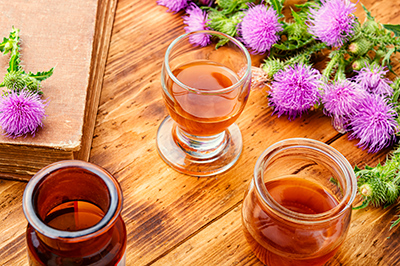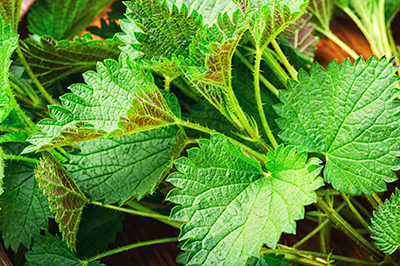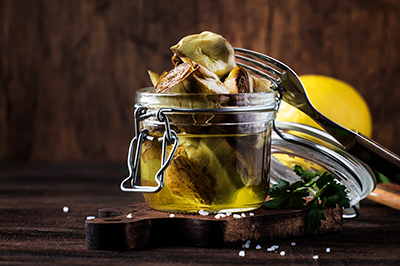Contents
Herbs for the gallbladder and liver exert two actions on the hepatobiliary system: choleretic and cholagogue. Bile production is one of the liver’s essential functions.

Plants with choleretic properties increase the amount of bile secreted by the liver. Bile is kept in the gallbladder until the passing of food produces its emptying in the intestine. By increasing bile production, choleretic plants reduce liver congestion and promote digestion. They are beneficial for liver disorders, such as hepatitis.
Herbs with cholagogue properties ease the emptying of the bile stored in the gallbladder to the duodenum. Cholagogue plants stop gallbladder and oddi sphincter spasms, alleviating pain and encouraging the correct functioning of the biliary system. They are used for biliary dyskinesia (slow gallbladder), biliary dyspepsia, and cholelithiasis (gallstones).
Herbs for the Gallbladder and Liver
Gallbladder and Liver Disorders
Liver Dysfunction: The liver is the most significant gland in our body. Many chemical reactions take place in it. It has three main functions:

- Transformation of nutrients into other nutrients.
- Bile production is needed to digest fats.
- Blood cleansing neutralizes and eliminates many foreign and toxic substances flowing into the blood system. Many of these herbs have choleretic properties; they favor bile secretion by hepatic cells. Hence, they reduce the congestion of the liver and enhance its function. Other plants stimulate the regeneration of hepatic cells when they have been damaged by several causes (viruses, medicines, toxic substances, etc.).
Hepatitis is liver swelling, usually caused by a virus. Its main symptom is jaundice, a yellowish skin coloring due to the liver’s inability to eliminate bile, which passes to the blood and permeates the skin and other tissues. Medicinal herb-based treatment enhances liver function so that this gland recovers to its best working conditions. The same herbs can be used as complementary substances to treat cirrhosis. Besides these herbs, all those with choleretic properties are helpful.
Liver Toxicity: When liver cells have been damaged by medicines, chemicals, chemical products, or poisonous mushrooms, these two plants can help enhance the liver’s anti-poisonous functions and regenerate its cells.
Fluid in the Abdomen: The accumulation of liquids in the peritoneal cavity is called ascites. Its most frequent cause is hepatic cirrhosis. These herbs activate blood flow in the portal system, reduce liver congestion, and promote the elimination of abdominal fluids. Hence, they improve the resolution of hepatic cirrhosis.

Gallbladder Dysfunction: The gallbladder must empty the bile stored at the right time so digestion usually continues. However, the bile emptying mechanism suffers from frequent disorders, shown in a bloated stomach, pain in the liver or the omoplates, nausea, and headaches. These disorders are often caused by gallstones or thick bile. Phytotherapy uses plants that can regulate the bile emptying mechanism and make bile more liquid, thus avoiding the formation of new gall stones. All cholagogue plants are also helpful.
Biliary colic: Biliary colic occurs when the gallbladder tries to expel a stone or calculus formed in its interior. It is an acute disorder that may last several days, with spasmodic contractions of the gallbladder and ducts by which the bile flows into the small intestine. This shows itself through pain, nausea, vomiting, and general discomfort. Besides these plants, all antispasmodic plants are also recommended.
Pancreatic insufficiency: All three of the following herbs mentioned promote the exocrine function of the pancreas, increasing the production of pancreatic juice, which is needed for digestion.
- Nettle: Stimulates production of pancreatic juice
- Papaya tree: Stimulates production of pancreatic juice
- St. Benedict Thistle: Promotes pancreas functioning
Choleretic and Cholagogue Herbs
Choleretic herbs increase the amount of bile secreted by the liver, and chollagogue herbs promote emptying the bile stored in the gallbladder into the duodenum.

Oranges, especially bitter oranges, have specific cholagogue properties; however, they are not important enough to appear in the table. This fact explains why many people, especially women, have digestive intolerance to oranges when taken as breakfast since they provoke a sudden gallbladder emptying.

Milk thistle is one of the most effective vegetal remedies for a liver disorder. Its active component, silymarin, is a substance that regenerates hepatic cells and plays a part in many pharmaceutical preparations.
All thistles are suitable for the liver. The artichoke not only enhances the functions of the hepatic gland but also decreases the cholesterol level in the blood. The part of the artichoke with the most medicinal properties is not used as a vegetable, but its leaves, stem, and root are consumed in infusions or fresh juices.
DISCLAIMER: All content on this website is presented solely for educational and informational objectives. Do not rely on the information provided as a replacement for advice, diagnosis, or treatment from a qualified medical expert. If you are pregnant, nursing, or have any preexisting medical concerns, talk to your doctor before using any herbal or natural medicines.
REFERENCES
- George D. Pamplona-Roger, M.D. “Encyclopedia of Medicinal Plants.” George D. Pamplona-Roger, M.D. Encyclopedia of Medicinal Plants. Ed. Francesc X. Gelabert. Vols. 1 San Fernando de Henares: Editorial Safeliz, 2000. 378, 379, 380, 381, 382. Print. [herbs for the gallbladder and liver]
- NIH: https://www.ncbi.nlm.nih.gov/pmc/articles/PMC6073929/
- Mount Sinai: https://www.mountsinai.org/care/liver-diseases/services
